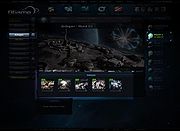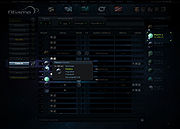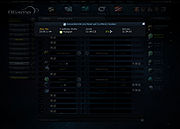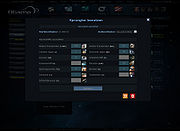Moon
Moons are one of the most important elements in OGame, not only because they allow you to securely save your fleet, but because they also can be used to intercept an enemy's fleet or to send your own ships to the other end of the universe in split seconds. For these reasons it's seriously recommended to work towards getting a moon as soon as you can afford it.
What is a moon?
Unlike planets, moons can't just be colonised they have to be created another way. If there's a big enough battle at a planet, causing a huge debris field to occur, then with a little luck this can become concentrated into a moon. A moon occurs only on a planet that's been attacked and only one moon can exist per planet. Size is important when it comes to moons, if your moon is too small then it can easily be deleted, after this the next big battle has a chance to create another moon.
The chance for a moon to form correlates to the amount of debris that's created. For every 100,000 resources in the debris field you have a 1% chance of getting a moon, up to a maximum of 20%, which equates to 2,000,000 resources; The equivalent of 1,667 Light Fighters - a number which will be more important later.
Moons created by a 19% or less moon chance will have a random size – whereby you either strike it lucky and get a big moon or get stuck with a smaller one, which are easier to destroy. However if you have a 20% chance, then you're guaranteed a moon that's at least 8,366 Kilometres in diameter, these are harder to destroy by other players and only at great effort and many losses.
How can I get a moon?
Because a moon only occurs on a planet where there's been a battle, it is clear that your planet must be attacked by another player. For the worst case, that means you haven't saved your fleet or you have saved it wrong and an enemy has destroyed it – at this point you can get a moon with a little luck as consolation. Of course it's better if you plan the attack and minimise your losses by just leaving a certain amount of ships on you planet. The best way is the already mentioned 1,667 Light Fighters, alternatively also 112 Battleships. This way the enemy destroys your ships, but you do not lose any more points than is necessary for a 20% moon chance – with a little skill you can also harvest the debris field and further reduce your losses.
The best option is of course to get away without using your own ships, and instead destroy those of the enemy. For that you have to set a little trap using some ships and resources as bait, and then wait until the enemy attacks. On the verge of arrival you have to prepare your whole combat fleet to get there and greet him. Make it so that he has to send enough fleet to produce a 20% chance, but not so much that your fleet can't destroy them, and with a little bit luck you get a moon for free and the debris field as bonus to boot.
If all those options are too insecure or too complex, you can also concentrate on so-called moon shots. Here you let another player attack you with 1,667 light fighters that will be destroyed, and you refund him his losses or you return the favour by destroying 1,667 light fighters on one of his planets too. Like that you can complete more tries faster to get a moon. Just be warned, this project can become very expensive - sure, you can get a moon after the first try, but there are also cases where it's taken several dozen attempts before a moon was achieved. A further consideration is the amount that you refund someone, if you pay more than the original cost of the ships then you might find yourself banned for breaking the pushing rule. More information can be found in the chapter regarding Moonshots and pushing.
I finally have a moon – Now what?
First of all you should send your whole fleet, including the resources, to the new moon because you can save more securely from there. Once that's completed you can expand your moon. Since a moon is significantly smaller than a planet extra fields must be activated first, the construction is as usual. The maximum amount of building slots isn't dependent on the size of the moon, but due to cost requirements it's basically 79.
First of all you have to build a lunar base, which in fact uses the single field but activates three further ones. For the further construction look to it that you upgrade the lunar base a further level as soon as there is only one field free, otherwise the moon is fully developed and you cannot build any further buildings. The 2 fields that you can use for other buildings between the levels of the lunar base, you should use first of all for the robotics factory and the sensor phalanx, one field also for the Jumpgate. The building of metal storages, crystal storages and deuterium tanks is completely pointless. They appear in the building menu but because you can't produce resources on a moon there's no reason to get them.
Based on the shortage of space and the long construction time, the shipyard is hardly profitable; ships can be produced significantly faster and easier on the planet. However, if you want, you can build the shipyard on your moon to assemble defensive structures and so to protect it from raids. But while building defensive structures you grievously notice the lack of the Nanite factory, the build-up of a bunker takes significantly longer on a moon. But it can be wise to protect any deuterium you leave there overnight with a few cannons, or to make it difficult to destroy the moon with Deathstars by building a few plasma turrets. After you are done building the defensive structures you should tear down the shipyard to get more space for the upgrade of the sensor phalanx. On a moon you can't build Anti-Ballistic Missiles but can still be attacked by IPMs; however fear not, for moons are defended by the anti-ballistic missiles on the corresponding planet, you should always ensure you have enough of them ready. You can find more detailed information on expanding the moon here: Moon guide.
What is the Sensor Phalanx?
The sensor phalanx is one of the strongest weapons that you can own in OGame. With it you can't destroy ships or attack planets, but it gathers useful information with which you can intercept enemy fleets. If you are on a moon with a constructed phalanx, you will be able to click on the names of enemy planets in the galaxy view up to a certain range. The range of a phalanx is calculated using the following formula: ((level of sensor phalanx)² - 1), so with a phalanx of level three you can scan eight systems in both directions. By clicking, a window will be opened, in which all fleets that are approaching the planet are listed - Now you know exactly when you have to strike to catch those ships. How much information you can see depends on the level of the espionage technology (level 2: total of the ships without ship type, level 4: number of the ships and ship types, level 8: ship types and their number). However you should use the sensor phalanx wisely, because every scan costs 5,000 deuterium. More information about using the Sensor Phalanx can be found in the chapter Blind phalanx guide.
How do I use the Jumpgate?
If you distribute your planets and moons throughout the galaxies, you will have to spend large amounts of deuterium to move your ships around. But once you have at least two moons with a jumpgate you can travel instantly without incurring any cost. You simply have to be on the starting moon and click on the button next to "Facilities", then in this new window type the number of ships you wish to send or alternatively click the "All ships" button to select all, and select the target moon to send to. Immediately after clicking the send button your ships will appear on the target moon.
Jumpgates are not only useful for moving fleets into new raiding areas, they are also good for setting traps to destroy enemy players. You'll learn more about that in the chapter Ninja guide. Unfortunately with the jumpgate you can't send resources with your ships, they still have to be transported with the fleet - remember to provide deuterium before jumping to the target moon, otherwise you might find yourself grounded with nowhere to go. Also bare in mind that jumpgates have to cool down for one hour before they can be used again. And finally, upgrading the jumpgate beyond level 1 is a pure waste of resources, the higher levels bring no added benefits besides more points for the highscores list.
How can I now fleet save safely?
A huge advantage of a moon is that it cannot be scanned by the enemy's sensor phalanx, hence the fleet movement is invisible. For this reason you can save significantly more securely with less effort by moon as by planet. For information on the best methods, see our chapter Saving.
How can my moon get destroyed?
Moons aren't invincible and so can be destroyed by the enemy. To do this requires Deathstars and is both risky and expensive. Anyhow, to be armed for this case have a look at the Moon destruction guide.



